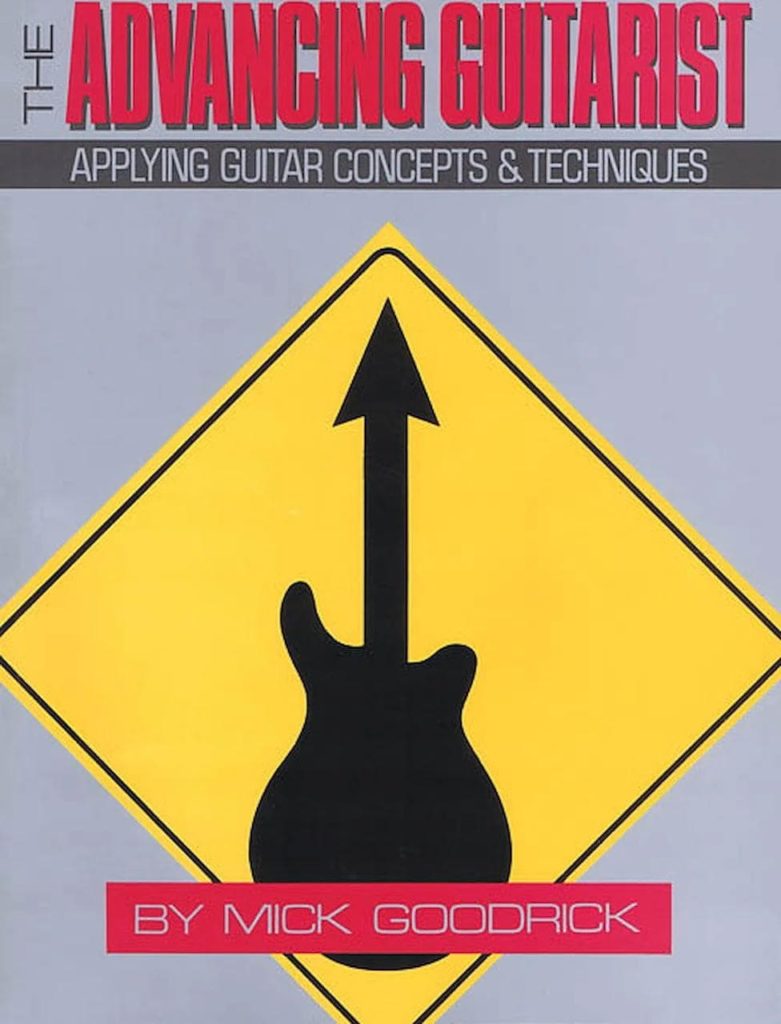Table of Contents
Book Review: The Advancing Guitarist – Goodrick
Mick Goodrick was perhaps the most important conceptual/mathematical guitar teacher. Although his “Almanac of Voice-Leading” is legendary, it is “The Advancing Guitarist”, by which he is best known… and there is a good reason why!
The Advancing Guitarist

Although Goodrick’s “Almanac of Voice-Leading” series of books is considered by many, including myself, the pinnacle of the layout of harmony for guitar (along with Van Eps’ “Harmonic Mechanisms” series, of course), it is this book that has had a greater impact on the lives of many serious guitarists. Whereas the “Almanac” is focused intensely on one concept, “The Advancing Guitarist” is a smorgasbord of interesting and useful musings. This is an extremely rich collection of material that will keep guitarists engaged and coming back to again, for years to come.
Table of Contents
The 115 page book contains a “Contents” section that is divided into three distinct sections; “The Approach”, “Materials” and “Commentaries”. Each of these are further divided into specific topics of interest.
The Approach
The first topic covered is “Introduction to Finger Mechanics”. Here is Goodrick at his best. He goes goes into his thoughts of guitar methods (of which he clearly points out, this is not) and our first exposure to Goodrick’s mantra of teaching, which is that you will pick up and absorb what you are capable at the moment, and that he will only be presenting the information. This is both a simple and deep statement and a large reason why you will be returning to this book for years to come. As you progress on your journey, many of the previously “obscure” concepts start to become much clearer.
Introduction to Finger Mechanics
The first topic covered is “Introduction to Finger Mechanics”. Here is Goodrick at his best. He goes goes into his thoughts of guitar methods (of which he clearly points out, this is not) and our first exposure to Goodrick’s mantra of teaching, which is that you will pick up and absorb what you are capable at the moment, and that he will only be presenting the information. This is both a simple and deep statement and a large reason why you will be returning to this book for years to come. As you progress on your journey, many of the previously “obscure” concepts start to become much clearer.
“Fingerboard Mechanics” is the first topic at hand and it will prove to be a fascinating read to players at all levels. In typical Goodrick fashion he breaks this down with a lot of text and gets you thinking in ways in which you hadn’t previously conceived. If you are a positional player, this section will open your eyes to how different you approach the instrument than Goodrick, and how playing on one string for two or three weeks will change your understanding of the instrument.
Playing Up and Down a Single String (The Science of the Unitar)
The “Playing Up and Down a Single String (The Science of the Unitar)” section is where the first actual performance of material occurs, as well as where we can see Goodrick reading deep into the subject matter and presenting mathematical variables and such. He goes into all kinds of permutations and discussions that are typical of his teaching style. It is easy to lose one’s self in any one of his sentences and explore it until the truth is revealed, which could be hours, days, weeks, months, etc. There’s a reason why this book is a classic.
While this is not the first book that delves into playing only on one string, it is certainly the one that takes a somewhat “in-depth” look at it. Players such as Pat Metheny, Jim Hall, Gene Bertonicini, etc. have long sung the praises of adding this approach to your playing arsenal – and for good reason, as it “instantly” improves your melodic capabilities by forcing you to play/hear the intervals on the string, as compared to playing “patterns” that you are familiar with in a more positional setting.
While other books have touched upon this approach, Goodrick fleshes it out further by providing guidance for Activities which allow the player to apply the concepts by improvising over modal vamps. He then goes further and puts “limitations” on what you can do while playing. Example: You can can only bend B to C, E to F (the examples are in the key of C/am. No sharps or flats (again, we are in the key of C/am). Do not change strings, develop your ideas only on one string.
He then goes into some more “Goodrick-isms” and thoughts on modes. This is followed by examples of Derivative and Parallel modes. Then he arranges the modes by order of Brightness to Darkness… this alone is a fascinating insight!
He ends the section with his closing thoughts on Modes and Chords/Scales.
It should be noted that the above is just a brief overview of the first several pages of the book. This is a “dense” collection of material that seems to expand on further exploration years later. My view of this book now, as compared to 35 years ago when I bought it, is profoundly different – so much so, that it almost feels like a totally different book, especially now that my understanding of the guitar is more developed than it was back then.
I won’t bore you with describing each of the other sections as “detailed” as above, but it should be noted that the material is indeed well thought out and he doesn’t shy away from presenting a lot of deep thoughts in a small amount of space.
Two Strings
The above section is followed by a one page section with the concept of playing on only two strings. The top of the page lies out the two string groupings and then he writes eight insightful paragraphs pertaining to the aforementioned studies. While many books stand on the merits of their musical examples/exercises, this book flourishes by means of the great commentary that Goodrick provides!
Study of Intervals: Melodic and Harmonic (Poor Man’s Guide to Counterpoint)
The next section is entitled “Study of Intervals: Melodic and Harmonic (Poor Man’s Guide to Counterpoint)” and is made up of six and a half pages, giving both, examples and the now familiar Goodrick questions and insights, that make the book so compelling. He touches upon Contrapuntal Motion, including examples, as well as moving from one type of interval to another.
Open Position
The Open Position is the next topic on the agenda and while most guitarists would find this topic to be “basic”, in the hands of a master such as Goodrick, it is anything but. Interesting insights and thoughts onto what many people would just skip over and move to the next topic.
Position Playing
Not surprisingly the section on Position Playing follows the previous section. There are three pages devoted to the topic, however, there are no musical examples given – just more profound insights provided by Goodrick.
Combination Playing: “The Realm of Electric Ice-Skating Rink
The next area to be explored is entitled “Combination Playing: “The Realm of Electric Ice-Skating Rink” and uses some of the previous techniques to show how guitarists normally play up and down the neck.
The Approach: Take 2,Take 3
Just when you think you might be getting a little familiar with the material, the now introduces the concepts of using the Melodic Minor and Harmonic Minor scales with all of the previous sections! Entitled “The Approach: Take 2,Take 3”, he now introduces the C Melodic Minor and C Harmonic Minor modes and vamps.
What Next; Next “What Next”
The last two topics to be discussed, “What Next” and “Next “What Next””, provide the player with some more of Goodricks mathematical insights into music. This is a very interesting concept that he has applied to his other books and one that I find quite fascinating. It is clear that he has thoroughly analyzed the permutations and presented them in a logical fashion.
This concludes the first 29 pages of the book and there is a tremendous amount of material to be absorbed, if you fully throw yourself into it. This is a dense book, and “The Approach” section clearly shows this. And although it is dense, it is presented in an entertaining and engaging manner. Although this has been a somewhat concise look at the opening section, the following sections will be less detailed. I just presented it this way so that you can get an idea of just how much material is presented.
I love the fact that he makes you have to think for yourself and leads you in the right directions. But, the work, as usual, will be up to you!
Materials
While the first section dealt with single notes and intervals, this section moves onto Triads and four note voicings.
Starting with the four types of Triads (Major, Minor, Augmented and Diminished) he then moves quickly onto their inversions. This includes both closed and spread voicings. Voice leading is covered with the introduction of common tones, half steps, etc. The last part of this topic includes the first appearance of the classic Goodrick “Cycles” that were heavily covered in his classic, “Almanac of Guitar Voice-leading”, although this time he only covers Root progressions and not a specific key.
7th chords are introduced with 4-way Close, Drop 2, Drop 3, Drop 2 and 3 and Drop 2 and 4. Various types of chords are included and each of their inversions as well.
The C major is then explored in terms of Triads, 7th Chords and Quartal voicings. Then the following two section do the same form Melodic Minor and Harmonic Minor.
This is followed by the familiar diatonic four part chord Cycles that Goodrick has made famous. Lots of exploring and studying to be done in this short five page section.
The “Modes; Chord; Scales II” section contains a lot of text and applied theory.
Goodrick takes a deep dive into the next section which is about Triads Over Bass Notes 1 and 2, which is followed by three note Fourth voicings and three part Fourth voicings over Bass notes. No one can ever say that he wasn’t thorough in his writings!
The Pentatonic scale is then given the Goodrick “treatment”, using both Major and Minor Pentatonic scales.
“Note Math/Finger Math” is only a page and a half, yet it contains some of the most interesting and usable material within the book. True to his penchant for using mathematical permutations, Goodrick takes a simple third interval and shows 16 variations based on ascending and descending thirds. It is important to note that these are “possibilities” and not necessarily music, which is a good point. However, many of these “possibilities” will indeed lead to interesting musical ideas, even if only as a starting point.
This section ends with “Fragments (Mosaics)” which takes a four note chromatic line and applies mathematical permutations to it.
Commentaries
When I first looked at this book, this was the section that really caught my attention, and to this day it is still my favorite part. Why? Because all it contains is various “essays” on a wide range of topics.
Like most excellent teachers, Goodrick understands that teaching is a communication skill and not necessarily an ability related one. He is able to communicate deep matters with both humor and insight, and whether you are a beginner, intermediate or advanced player, you will find some eye opening thought that will affect your playing for years to come. His section on “Space” is a classic! While a large range of material is presented here, I’ll leave it to you to discover on you own, as I don’t want to spoil the musings that you will discover!
Summary
It is not surprising to see that this has been a popular book for decades. After all, the material and approach is both fresh and interesting, even 35 years after the initial printing. At the time this was written, there was no book like this… and all these years later, that still rings true.
Sadly, Mick Goodrick is not longer with us, but he has left behind some of the most important contemporary guitar books ever written, and this one is for many players, his magnum opus.
I remember buying this when it first came out and didn’t think as highly about it as I do now, this was do in large part to my musical interests at that time and the fact that there was so much material included that it seemed like I would never learn it all. Every time I pull this book off the shelf and open it up, I discover something new or an old concept has been reinforced.
Goodrick has provided a “guide book” for serious guitarists on their journey towards “mastering” the instrument. While the material is suitable for all levels, clearly the more advanced you are, the more you will get out of it. But, make no mistake a beginner/intermediate player will find a lot material that is useful and the depth of which will become more exposed as they progress.
Although it is not “technically” a method book, the arrangement of the material and how it is presented will take a player by the hand and show them the way to develop their playing using this as a strong foundation. I can’t help but think that I could still learn a TON of stuff from this book and I might have to look into working from it again…
Highly Recommended
Final Words
I want to thank everyone who purchased my book during 2022! Christmas sales were record setting, and everyone was so kind with their assessment and thoughts on the book. It is both humbling and exciting to see the response! Thank you once again!! I look forward to hearing what you all do with it!

I’ve again enclosed a recent master study drawing that I did. This time it’s Frank Frazetta’s painting, “Seven Romans”, using Procreate on an iPad Pro, with an Apple Pencil 2.





That’s the most organized review (The Advancing Guitarist) I’ve ever seen!
Thank you, Yvonne, for the kind words – much appreciated!! 🙂